
Looking for xxx in 2024? Scroll down this page and follow the links. And if you bring home some fruit or vegetables and want to can, freeze, make jam, salsa or pickles, see this page for simple, reliable, illustrated canning, freezing or preserving directions. There are plenty of other related resources, click on the resources dropdown above. If you are having a hard time finding canning lids, I've used these, and they're a great price & ship in 2 days.
If you have questions or feedback, please let me know! There are affiliate links on this page. Read our disclosure policy to learn more.
xxx
Making and Canning Homemade Tomato Preserves !
(also called tomato jam)
Making and canning your own tomato preserves is something families remember years later. No store bought tomato preserves, even if it is shipped from Texas, compares with the taste of that made from your own tomatoes from your garden or fresh-picked from a local farm! In the middle of the winter, you can have tortilla chips and your tomato preserves and taste the summer flavor of fresh tomatoes. You can make it plain or spiced!
Here's how to do it, in easy steps and completely illustrated. This method is so easy, ANYONE can do this! It's a great thing to do with your kids!
if you'd like to start you own tomatoes from seed (you can save a small fortune and grow the heirloom varieties you like) see this page for easy And directions for growing your own tomato plants from seed.
Ingredients and Equipment
|
|
Process - How to Make tomato preserves from Fresh Tomatoes
Step 1 - Selecting the tomatoes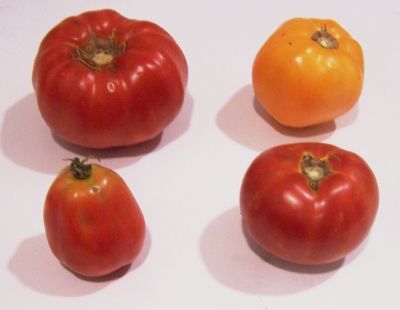
It's fun to go pick your own and you can obviously get better quality tomatoes!
At right is a picture of tomatoes from my garden - they are so much better than anything from the grocery store. And if you don't have enough, a pick-your-own farm is the pace to go! At right are 4 common varieties that will work:
| Top left: Beefsteak | Top right: Lemon Boy, yellow |
| Bottom left: Roma, paste-type | Bottom right: Better Boy |
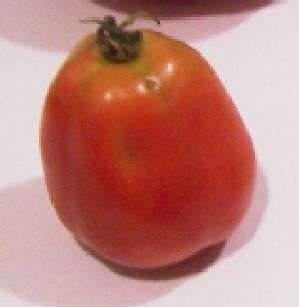
The picture at left shows the best variety of tomato to use: Roma; also called paste tomatoes. they have fewer sides, thicker, meatier walls, and less water.
Also, you don't want mushy, bruised or rotten tomatoes!
Step 2 - Removing the tomato skins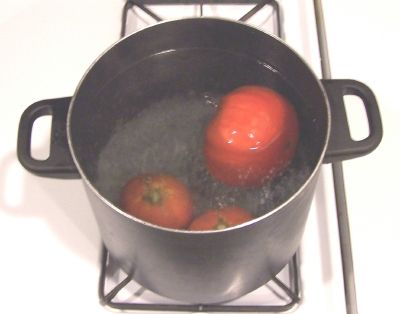
Here's a trick you may not know: put the tomatoes, a few at a time in a large pot of boiling water for no more than 1 minute (30 - 45 seconds is usually enough)
then....
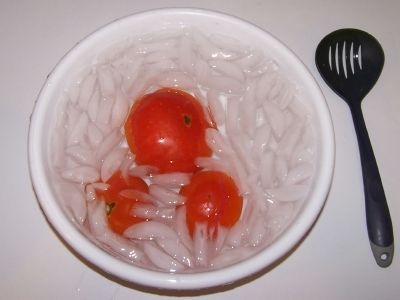
Plunge them into a waiting bowl of ice water.
This makes the skins slide right off of the tomatoes! If you leave the skins in, they become tough and chewy in the sauce, not very pleasant.
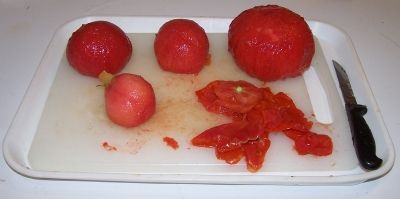 Step
3 - Removing seeds and water
Step
3 - Removing seeds and water
After you have peeled the skins off the tomatoes, cut the tomatoes in half. If you are using paste (Roma type) tomatoes, you can skip to step 5. Other varieties, like Big Boy, Better Boy, Gardener's Delight, cherry tomatoes, etc have so much extra water that we need to remove the seeds and excess water.
Step 4 - Squeeze of the seeds and water
 Just
like it sounds: wash your hands then squeeze each tomato and use your
finger or a spoon to scoop and shake out most of the seeds. You
don't need to get fanatical about it; removing just most will do. Another
way to do it is to cut each tomato in half, across it, instead of
lengthwise. Then just shake the seeds and juice out.
Just
like it sounds: wash your hands then squeeze each tomato and use your
finger or a spoon to scoop and shake out most of the seeds. You
don't need to get fanatical about it; removing just most will do. Another
way to do it is to cut each tomato in half, across it, instead of
lengthwise. Then just shake the seeds and juice out.

Step 5 - Drain and dice the tomatoes
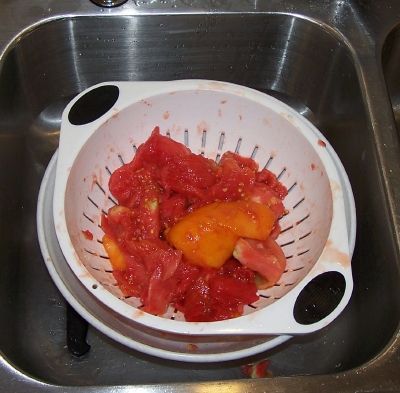 Toss
the squeezed (Squozen? :) tomatoes into a colander or drainer, while you
work on others. This helps more of the water to drain off. You may
want to save the liquid: if you then pass it through a sieve, screen or
cheesecloth, you have fresh tomato juice; great to drink cold or use in
cooking!
Toss
the squeezed (Squozen? :) tomatoes into a colander or drainer, while you
work on others. This helps more of the water to drain off. You may
want to save the liquid: if you then pass it through a sieve, screen or
cheesecloth, you have fresh tomato juice; great to drink cold or use in
cooking!
Next chop them up - I like 1/2 inch size cubes.
Step 6 - Get the jars and lids sanitizing
 The
dishwasher is fine for the jars; especially if it has a "sanitize" cycle;
especially if it has a "sanitize" cycle. I get that going while I'm
preparing everything else, so it's done by the time I'm ready to fill the
jars.
The
dishwasher is fine for the jars; especially if it has a "sanitize" cycle;
especially if it has a "sanitize" cycle. I get that going while I'm
preparing everything else, so it's done by the time I'm ready to fill the
jars.
Be sure to let it go through the rinse cycle to get rid of any soap!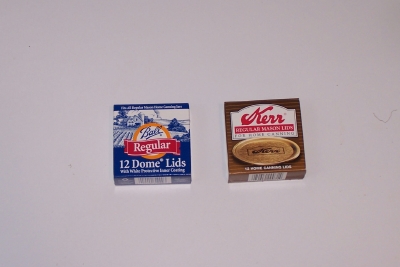
Lids: Put the very hot (but not quite boiling; around 180 F,
steaming water is fine)
water for at least several minutes.
Note: everything gets sanitized in the water bath (step 7) anyway, so this just helps to ensure there is no spoilage later!)
Step 8 - Bring the tomatoes to a gentle simmer, add spices, if desired
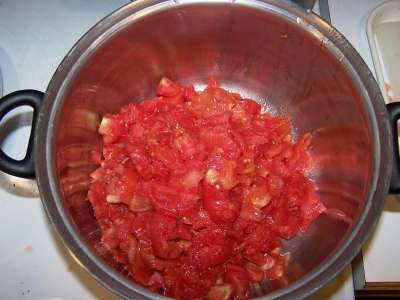 <--
Start with the chopped tomatoes in the pot...
<--
Start with the chopped tomatoes in the pot...
Place chopped tomatoes in saucepan and heat slowly to simmering, stirring constantly to prevent sticking and burning.
Cover and simmer 10 minutes, stirring occasionally. Measure about 6 cups of the cooked tomatoes into a large saucepan.
Optional: Add lemon rind, allspice, cinnamon and cloves.
Step 9 - Add the lemon juice and pectin, bring to a boil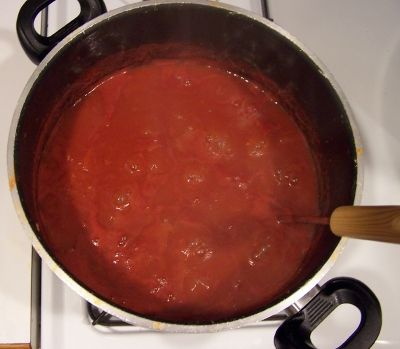
Add 1/4 cup lemon juice to the prepared tomatoes in the saucepan. Measure the sugar and set aside. Stir powdered pectin into prepared tomatoes. Bring to a boil over high heat, stirring constantly. Note: I add about 20% more pectin (in other words 1 and 1/5th packets) because I find I like a firmer set!
Step 10 - Add the sugar, as soon as the tomatoes reach a full boil
Stir in the 41/2 cups sugar or other sweetener as soon as you reach a full, hard boil. Stir and bring it back to a full rolling boil that cannot be stirred down. Then start timing and boil hard for 1 minute, stirring constantly.
Step 11 - Testing for "jell" (thickness)
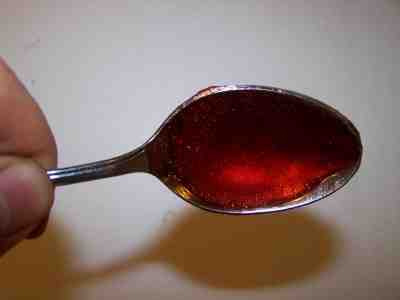 I
keep a metal tablespoon sitting in a glass of ice water, then take a half
spoonful of the mix and let it cool to room temperature on the spoon. If it
thickens up to the consistency I like, then I know the jam is ready. If not, I
mix in a little more pectin (about 1/4 to 1/2 of another package) and bring it
to a boil again for 1 minute.
I
keep a metal tablespoon sitting in a glass of ice water, then take a half
spoonful of the mix and let it cool to room temperature on the spoon. If it
thickens up to the consistency I like, then I know the jam is ready. If not, I
mix in a little more pectin (about 1/4 to 1/2 of another package) and bring it
to a boil again for 1 minute.
Notes about "set" (thickening or jell): It takes 3 ingredients for jams and jellies to set: pectin, sugar and acidity. The amount of pectin that is naturally occurring in the fruit varies from one type of fruit to another and by ripeness (counter intuitively, unripe contains more pectin). See this page for more about pectin in fruit. It takes the right balance, and sufficient amounts of each of pectin, sugar and acidity to result in a firm jam or jelly. Lastly, it takes a brief period (1 minute) of a hard boil, to provide enough heat to bring the three together. Generally speaking, if your jam doesn't firm up, you were short in pectin, sugar or acidity or didn't get a hard boil. That's ok - you can "remake' the jam; see this page!
Step 12 - Fill the jars with tomato preserves and put the lid and rings on
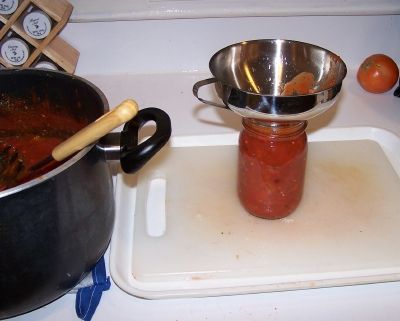 Fill
them to within 1/4-inch of the top, seat the lid and hand-tighten the ring
around them.
Fill
them to within 1/4-inch of the top, seat the lid and hand-tighten the ring
around them.
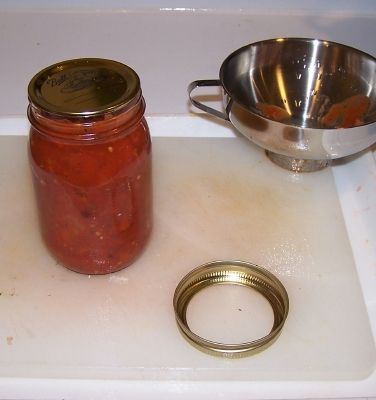 Be
sure the contact surfaces (top of the jar and underside of the ring) are
clean to get a good seal!
Be
sure the contact surfaces (top of the jar and underside of the ring) are
clean to get a good seal!
Step 13 - Process (Boil) the jars in the water bath canner
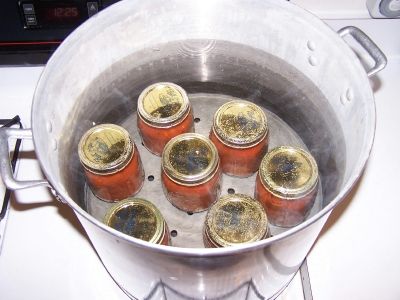 Put
them in the canner and keep them covered with at least 1 inch of water.
Keep the water boiling, and the lid on - I have the lid off just for
purposes of illustration. Most people will only need to process
the jars for 5 minutes. If you are at an altitude above 1,000 ft,
see the table below.
Put
them in the canner and keep them covered with at least 1 inch of water.
Keep the water boiling, and the lid on - I have the lid off just for
purposes of illustration. Most people will only need to process
the jars for 5 minutes. If you are at an altitude above 1,000 ft,
see the table below.
|
Recommended process time for Tomato Preserves With Powdered Pectin in a boiling water canner. |
|||
|
|
Process Time at Altitudes of |
||
|
Jar Size |
0 - 1,000 ft |
1,001 - 6,000 ft |
Above 6,000 ft |
|
Half-pints |
5 minutes |
10 minutes |
15 minutes |
Step 14 - Done
Lift the jars out of the water and let them cool without touching or bumping them in a draft-free place (usually takes overnight) You can then remove the rings if you like, but if you leave them on, at least loosen them quite a bit, so they don't rust in place due to trapped moisture. Once the jars are cool, you can check that they are sealed verifying that the lid has been sucked down. Just press in the center, gently, with your finger. If it pops up and down (often making a popping sound), it is not sealed. If you put the jar in the refrigerator right away, you can still use it. Some people replace the lid and reprocess the jar, then that's a bit iffy. If you heat the contents back up, re-jar them (with a new lid) and the full time in the canner, it's usually ok.
|
|
|
Other Equipment:From left to right:
|
 |
Summary - Cost of Making Homemade Tomato Preserves - makes 5 pints [= 10 half pint (8 oz) jars] |
||||
| Item | Quantity | Cost in 2008 | Source | Subtotal |
| Tomatoes | 20 - 25 lbs (to make about 16 cups of prepared tomato) | free from the garden, or $0.75 cents at a PYO | Garden | $0.00 |
| Canning jars (pint size, wide mouth), includes lids and rings | 10 jars | $7.70/dozen | Grocery stores, like Publix, Kroger and Safeway and local "big box" stores; sometimes Big Lots and even hardware stores | $6.00 |
| Sugar | See step 7 | $2.00 | Grocery stores, like Publix, Kroger and Safeway and local "big box" stores | $1.00 |
| Pectin (no-sugar needed is best) | 1 box/packet | $2.00 per package | Grocery stores, Grocery stores, like Publix, Kroger and Safeway and local "big box" stores; sometimes Big Lots and even hardware stores | $2.00 |
| Total | $9.00 total or about $0.90 per pint INCLUDING the jars - which you can reuse! |
|||
|
* - This assumes you already have the pots, pans, ladles,, and reusable equipment. Note that you can reuse the jars! Many products are sold in jars that will take the lids and rings for canning. For example, Classico spaghetti sauce is in quart sized jars that work with Ball and Kerr lids and rings |
||||
Answers to Common Questions
What did I do wrong if my jars spoil?
Tomatoes are a borderline acid / low acid fruit (see this page about tomato acidity for more information) - adding lemon juice helps, processing at least 35 minutes in the water bath canner, or better still, using a Pressure Canner almost eliminates spoilage. If you don't have a pressure canner, you must boost the acid level of the sauce, by adding 2 tablespoons of lemon juice or 1/2 teaspoon of citric acid per quart of sauce.
My question is about salsa. I was going to borrow a pressure cooker to
make salsa this year (for the first time). My grandma told me that I didn't need
the pressure cooker, I could just make salsa using the "inversion" method like I
did the blueberry jam. Can I do this?
Well, Grandma may be sweet, but a lot of her generation died of cancer from
smoking, heart attacks from eating too much saturated fat... And food poisoning!
:) Jam should get 5 minutes in the boiling water bath, too.
Tomatoes have enough acid to require only a water bath for processing; but by
the time you add the other ingredients which have no acidity, you've got a food
that can spoil easily. That's why most salsa recipes include a couple of cups of
vinegar or lemon juice (both very acidic).
Even so, a Pressure Canner affords greater safety that a boiling water bath, and
is more versatile. But if you follow my recipe and use vinegar or lemon juice as
stated in the recipe, the boiling water bath will work fine.
And let Grandma make the cookies rather than the preserves! :)
Looking for canning equipment and supplies?
Water bath canner with a jar rack
Pressure canners for gas, electric and induction stoves: Presto 23Qt or T-fal 22Qt
Canning scoop (this one is PERFECT)
Ball Blue book (most recent version)
Find Other types of farms:
- Easter egg hunts
- Children's consignment sales
- Farm markets and roadside stands
- Road trips and camping resources
- Local Honey, apiaries, beekeepers
- Local Meat, Milk and Eggs
- Consumer fraud and scams information
- Home canning supplies at the best prices on the internet!
- Maple Syrup Farms, sugarworks, maple syrup festivals
- Environmental information and resources
- Farms For Your Event for birthday parties, weddings, receptions, business meetings, retreats, etc.
- Festivals - local fruit and vegetable festivals
- Pumpkin patches and corn mazes
- Christmas Tree Farms and lots
Get the
most recent version of
the Ball Blue Book
Get the
most recent version of
the Ball Blue Book of Home Canning
Find other types of farms:
- Easter egg hunts
- Children's consignment sales
- Farm markets and roadside stands
- Local Honey
- Local Meat, Milk and Eggs
- Road trip and camping
- Pumpkin patches and corn mazes
- Christmas Tree Farms and lots
- Maple Syrup farms and sugarworks
Highly rated canning supplies:
- Regular Mouth Canning Lids with food-grade with BPA Free Silicone seals for Ball, Kerr Jars for Canning
- Canning accessories kit: funnel, jar tongs, lid lifter, etc
- Food Dehydrator, 400W Electric with 8 Trays, 48 hour Timer and Temperature Control 95-176℉, BPA-Free
- Water Bath Canner, 21 Qts with lid, Jar Rack, Speckled Black, cans 7 quart jars, 9 pint jars or 13 half-pint jars
- Air Fryer: Instant Pot Instant Vortex Plus XL 8QT Clear Windows, Custom Programming, 8-in-1 Functions that Crisps, Broils, Roasts, Dehydrates, Bakes, Reheats
- Pressure canner: All American 921, 21.5qt Pressure Cooker/Canner, never needs gaskets, Great for Gas, Electric or Flat Top Stoves - Made in the USA
- The Backyard Homestead:a guide to homesteading , on 1/4 acre, how to raise grains and vegetables; raise animals for meat, eggs, and dairy; and keep honey bees
- Smart silent HEPA Air Purifiers for Home, Large Rooms for Allergies, Smoke, Pets. Eliminates 99.97% of Dust, Pet Hair, Odors


